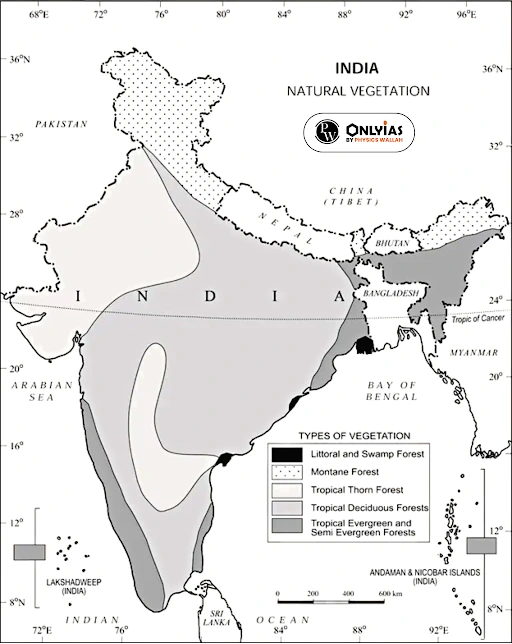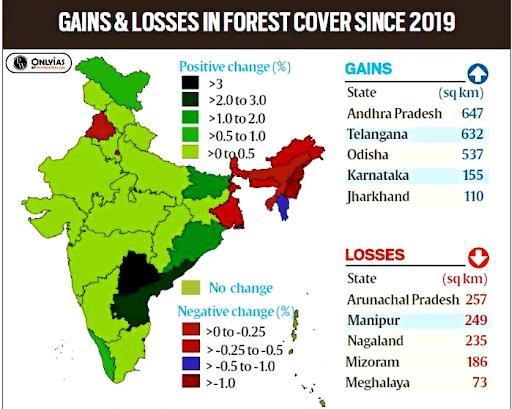Forests in India: An Overview of Biodiversity, Types, and Conservation
Forests in India are diverse and ecologically significant, encompassing a wide range of ecosystems and species. As India is one of the world’s biodiversity hotspots, its forests in India play a crucial role in conserving this diversity. With about 47,000 plant species, India occupies the tenth place in the world and fourth in Asia in plant diversity. India also has approximately 90,000 species of animals, as well as a rich variety of fish in its fresh and marine waters.
About Indian Forest:
- Forests in India are renowned for their rich biodiversity and contribute various valuable products, including timber, bamboo, medicinal plants, and non-timber forest products.
- Forest cover in India varies by region and can be broadly categorized into several types, including tropical rainforests, deciduous forests, evergreen forests, and alpine forests.
Status of Forests in India: A Look at Forest Cove:
|
Forests in India: A Variety of Forest Types Defined by Unique Ecological Characteristics
- The following major types of vegetation identified in forests in India are:
-
- Tropical Evergreen and Semi Evergreen Forests
-
- Tropical Deciduous Forests
-
- Tropical Thorn Forests and Scrubs
-
- Montane Forests
-
- Littoral and Swamp Forests.

Tropical Evergreen and Semi Evergreen Forests:
- Forests in India: Unique Locations – Western Ghats, Islands, and More:
These forests are restricted to heavy rainfall areas of the western slope of the Western Ghats and the island groups of Lakshadweep, Andaman and Nicobar, upper part of Assam and Tamil Nadu coast.- The semi evergreen forests are found in the less rainy parts of these regions.
- Such forests have a mixture of evergreen and moist deciduous trees.
- Forests in India: Exploring the Climate Varieties: Warm and humid conditions with an annual precipitation of over 200 cm.
- Annual temperature: Mean annual temperature above 22 degree Celsius.
- Exploring Forests in India: Their Unique Characteristics: Stratified with layers closer to the ground and covered with bushes and creepers
- Short structured trees followed a tall variety of trees.
- Trees reach great heights up to 60 m or above.
- These woods seem green all year round.
- Floral composition:
- Moist Evergreen Forests: Rosewood, mahogany, Aini, ebony, etc are some of the important trees of Moist Evergreen Forests.
- Semi Evergreen forests: While, white cedar, hollock and kail are the main species of Semi Evergreen forests.
- Faunal composition: Elephants, monkey, lemur and deer, one-horned rhinoceros are found in jungles of Assam and West Bengal.
- Plenty of birds, bats, sloth, scorpions and snails etc. are also found.
Tropical Deciduous Forests in India: A Closer Look
- Also known as monsoon forests. They are the most widespread forest in India.
- Climatic condition: They spread in areas with rainfall ranging from 70 to 200 cm.
- Division: Based on the availability of water and rainfall, they are divided into:
- Tropical Moist Deciduous Forests.
- Dry deciduous Forest.
- Tropical Moist Deciduous Forests:
- Location: Northeastern states along the foothills of Himalayas, eastern slopes of the Western Ghats and Odisha.
-
- Climatic condition: Rainfall between 100-200 cm.
- Floral Composition: Teak, sal, shisham, hurra, mahua, amla, semul, kusum, and sandalwood etc.
- Faunal Composition: Mammals include the predators Indian tiger, wolf, dhole, and sloth bear, and the herbivores gaur, chousingha, blackbuck, and chinkara.
- Tropical Dry deciduous Forest:
- Location: Rainier areas of the Peninsula and the plains of Uttar Pradesh and Bihar.
- In the higher rainfall regions of the Peninsular plateau and the northern Indian plain.
- Climatic condition: Rainfall ranges between 70 -100 cm.
- Characteristics:
- Location: Rainier areas of the Peninsula and the plains of Uttar Pradesh and Bihar.
-
-
- Depends on precipitation: On the wetter areas it changes to moist deciduous, while on the drier margins to thorn forests.
- Parkland topography: Forests often include open stretches with teak and other trees mixed with patches of grass, giving the area a parkland-like appearance.
- Falling of leaves: When the dry season arrives, the trees totally lose their leaves, turning the forest into a huge meadow with bare trees all around.
-
Floral composition: Tendu, palas, amaltas, bel, khair, axlewood, etc.
India’s Unique Dry Thorn Forests: An Exploration:
-
- Location: It includes semi-arid areas of south west Punjab, Haryana, Rajasthan, Gujarat, Madhya Pradesh and Uttar Pradesh.
- Climatic Condition: Tropical thorn forests occur in the areas which receive rainfall less than 50 cm.
- Characteristics: Variety of grasses and shrubs, plants remain leafless for most part of the year.
- Have an expression of scrub vegetation.
- Floral Composition: Babool, ber, and wild date palm, khair, neem, khejri, palas, etc.
- Location: It includes semi-arid areas of south west Punjab, Haryana, Rajasthan, Gujarat, Madhya Pradesh and Uttar Pradesh.
Forests in India: Exploring Mountain Ecosystems
- Vegetation: In mountainous areas, decrease in temperature with increasing altitude leads to a corresponding change in natural vegetation.
- Classification: Mountain forests can be classified into two types, the northern mountain forests and the southern mountain forests.
- The southern mountain forests: It includes the forests found in Peninsular India viz; the Western Ghats, the Vindhyas and the Nilgiri.
- Northern montane forests: It includes mountain ranges in Kashmir, Uttarakhand, Himachal Pradesh, Sikkim and Darjeeling.
- Climatic condition:
- Precipitation:The mean annual rainfall here is 150 cm to 300 cm.
- Temperature: The mean annual temperature is about 11°C to 14°C.
- Humidity: Average relative humidity is over 80 per cent.
- Characteristics:
- It is followed by moist temperate forests, which are found between 1,000 and 2,000 meters above sea level.
- Shola forest: The Sholas in the Nilgiris, Anaimalai, and Palani hills are temperate forests.
- Floral composition: Mosses and lichens are a part of the tundra vegetation at higher altitudes.
- Significant trees: Other economically significant trees in this forest include the magnolia, laurel, cinchona, and wattle.
- Faunal composition: Hangul or Kashmir Stag, Shou or Sikkim Stag, Red Panda, Elephants, Sambhar, Swamp deer etc.
India’s Coastal Littoral Forests: Home to Unique Plants and Wildlife
- Withstand saltwater: Forests with plants that can withstand saltwater are known as littoral forests.
- Location: Along the coast and of the islands and to the deltas of the Ganga, the Mahanadi, the Godavari, the Krishna and the Cauvery.
- Characteristics:
- Waterlogged soil: Swamp forests grow on peat-poor soils that are always waterlogged.
- Swamp formation: They may be produced and kept in place by hydrological barriers, high water tables, or land topography (basin swamps).
- Habitat: Aquatic habitats in swamp forests may be sporadic, seasonal, or permanent.
- Floral Composition: Mostly consists of palms, whistling pines, mangroves, etc.
- To allow the plant to breathe in the water, they have roots made of spongy tissue.
- Faunal Composition: Saltwater crocodiles, marine turtles, coconut crab, lizards, snakes.
Conclusion
- Forests in India are not only home to a diverse array of plant and animal species but also play a crucial role in maintaining ecological balance, providing valuable ecosystem services, and supporting the livelihoods of millions of people in forests in India.































